Uber Corporate Governance Case Study
VerifiedAdded on 2020/02/14
|23
|6768
|2450
Case Study
AI Summary
This case study examines Uber's corporate governance, focusing on ethical issues and risk management. It analyzes Uber's structure, board of directors, and past scandals, applying relevant theories like stakeholder theory and legitimacy theory. The study identifies key governance issues, including ethical lapses, risk management failures, and stakeholder concerns. It proposes solutions, discusses the possibility of similar events, and offers personal reflections on lessons learned. Finally, it evaluates the investment attractiveness of Uber, considering its strengths, weaknesses, opportunities, and threats.
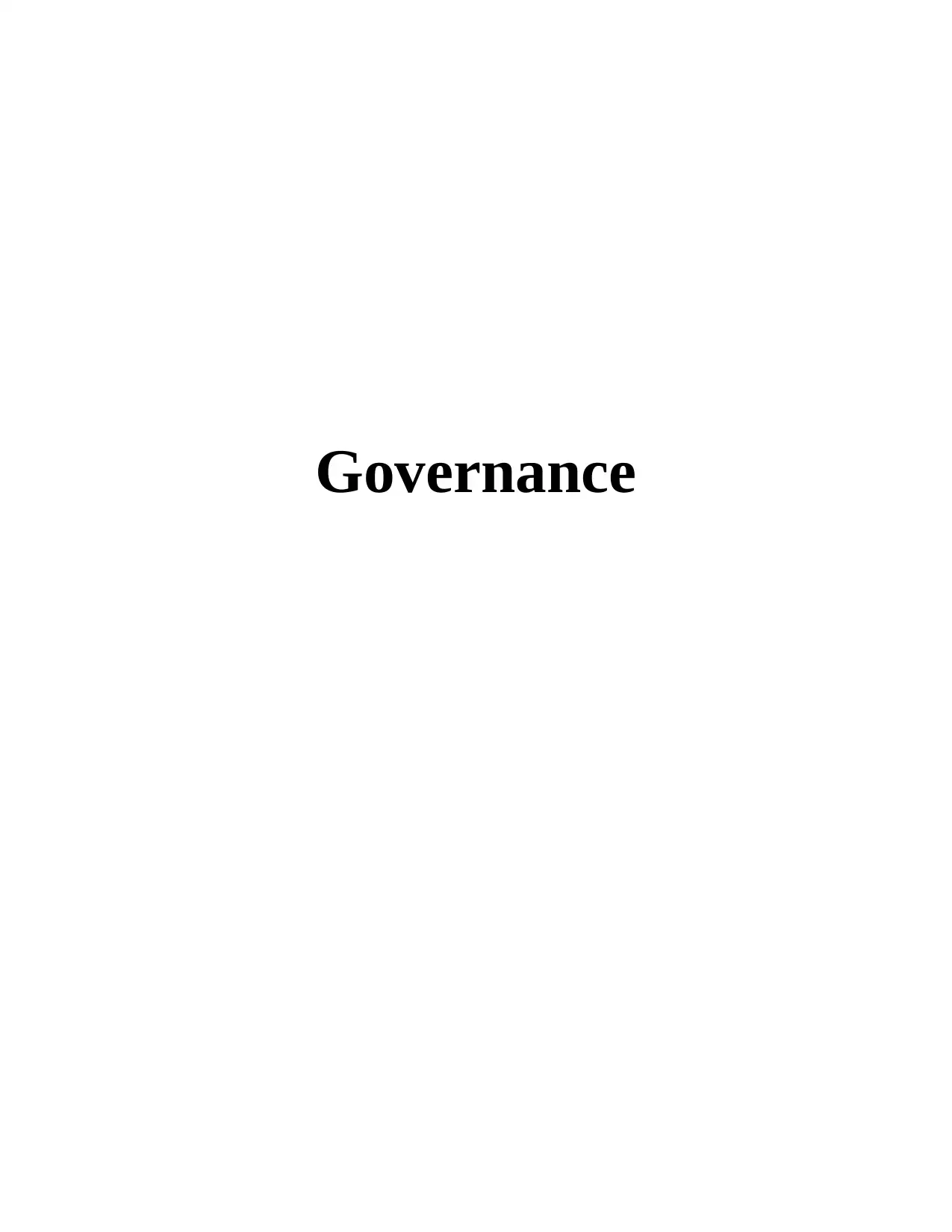
Governance
Paraphrase This Document
Need a fresh take? Get an instant paraphrase of this document with our AI Paraphraser
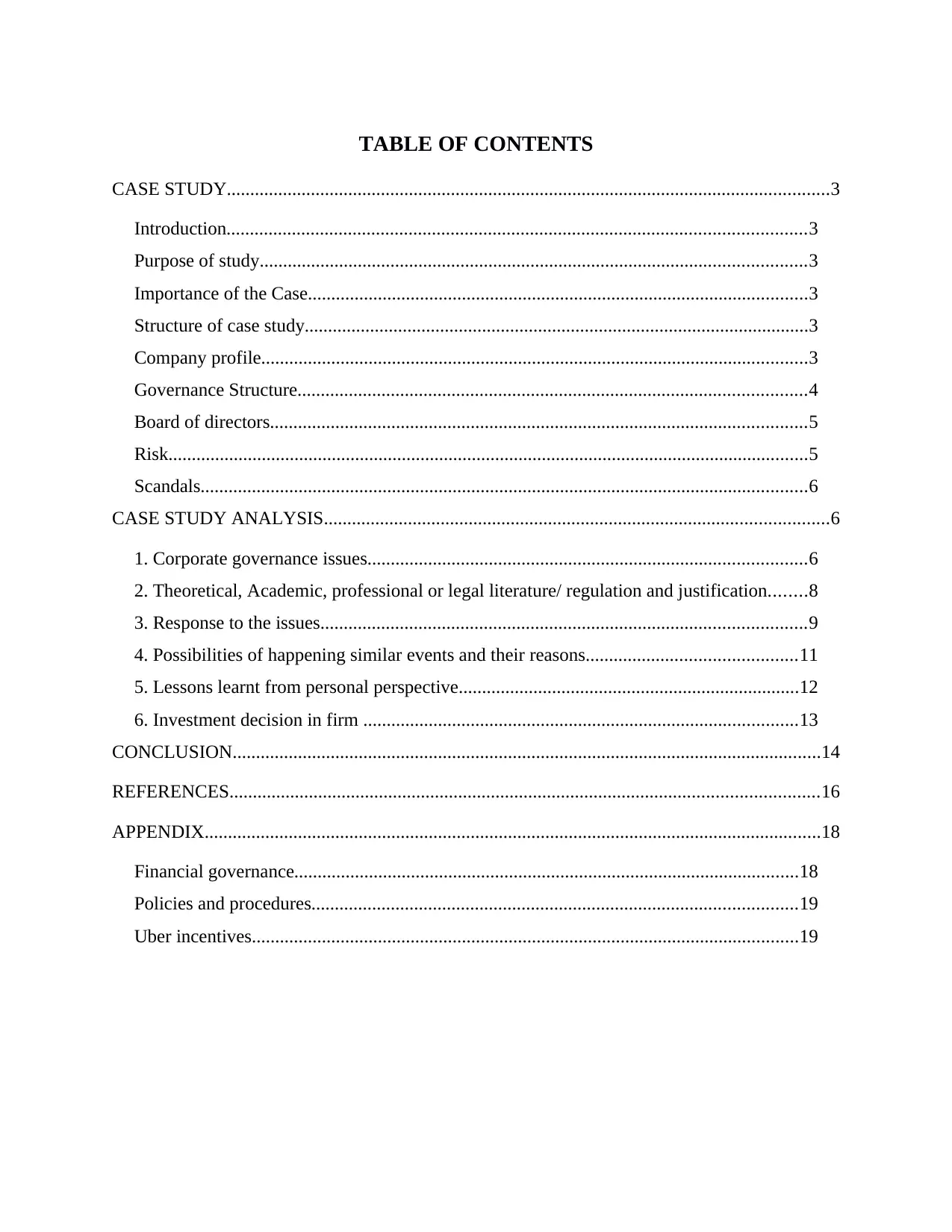
TABLE OF CONTENTS
CASE STUDY.................................................................................................................................3
Introduction............................................................................................................................3
Purpose of study.....................................................................................................................3
Importance of the Case...........................................................................................................3
Structure of case study............................................................................................................3
Company profile.....................................................................................................................3
Governance Structure.............................................................................................................4
Board of directors...................................................................................................................5
Risk.........................................................................................................................................5
Scandals..................................................................................................................................6
CASE STUDY ANALYSIS............................................................................................................6
1. Corporate governance issues..............................................................................................6
2. Theoretical, Academic, professional or legal literature/ regulation and justification........8
3. Response to the issues........................................................................................................9
4. Possibilities of happening similar events and their reasons.............................................11
5. Lessons learnt from personal perspective.........................................................................12
6. Investment decision in firm .............................................................................................13
CONCLUSION..............................................................................................................................14
REFERENCES..............................................................................................................................16
APPENDIX....................................................................................................................................18
Financial governance............................................................................................................18
Policies and procedures........................................................................................................19
Uber incentives.....................................................................................................................19
CASE STUDY.................................................................................................................................3
Introduction............................................................................................................................3
Purpose of study.....................................................................................................................3
Importance of the Case...........................................................................................................3
Structure of case study............................................................................................................3
Company profile.....................................................................................................................3
Governance Structure.............................................................................................................4
Board of directors...................................................................................................................5
Risk.........................................................................................................................................5
Scandals..................................................................................................................................6
CASE STUDY ANALYSIS............................................................................................................6
1. Corporate governance issues..............................................................................................6
2. Theoretical, Academic, professional or legal literature/ regulation and justification........8
3. Response to the issues........................................................................................................9
4. Possibilities of happening similar events and their reasons.............................................11
5. Lessons learnt from personal perspective.........................................................................12
6. Investment decision in firm .............................................................................................13
CONCLUSION..............................................................................................................................14
REFERENCES..............................................................................................................................16
APPENDIX....................................................................................................................................18
Financial governance............................................................................................................18
Policies and procedures........................................................................................................19
Uber incentives.....................................................................................................................19
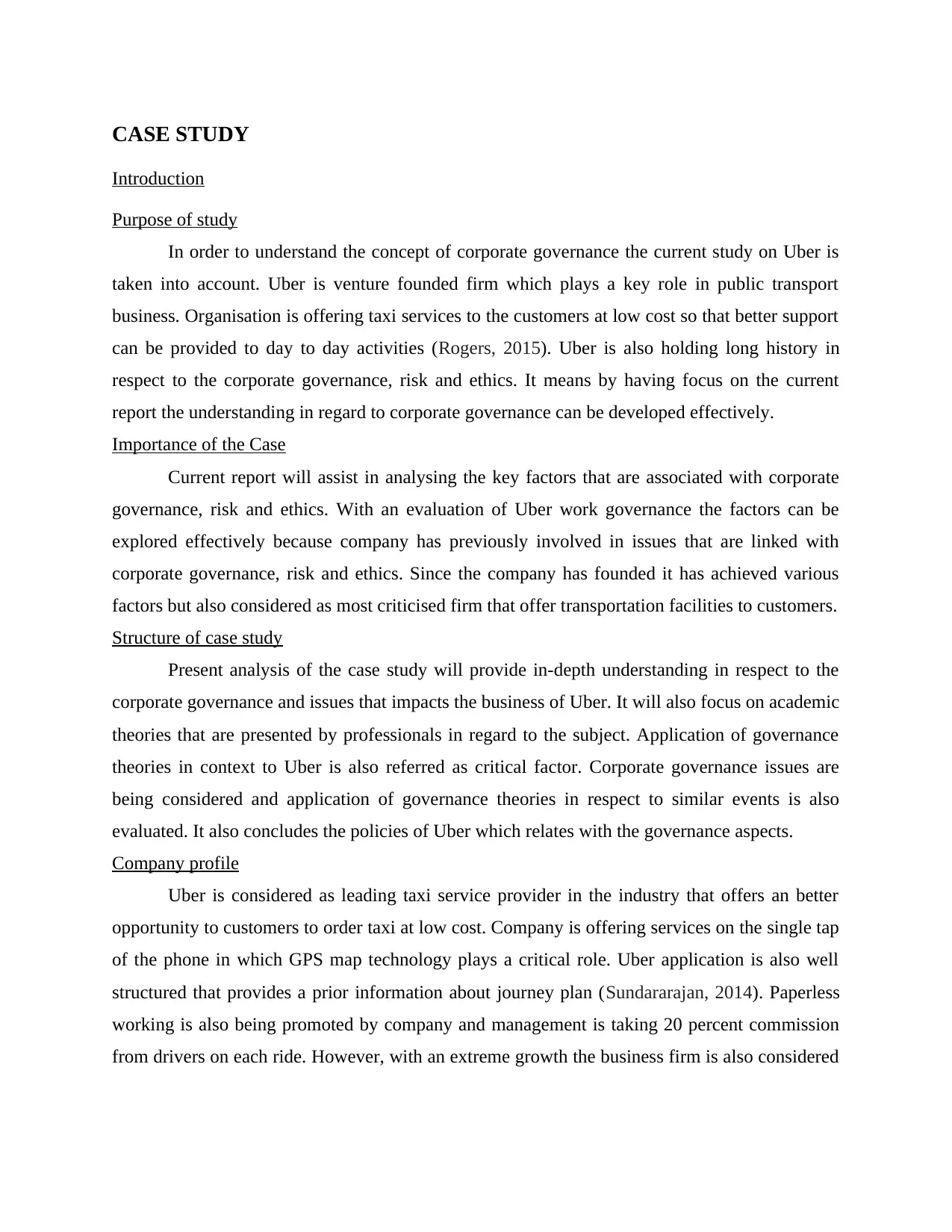
CASE STUDY
Introduction
Purpose of study
In order to understand the concept of corporate governance the current study on Uber is
taken into account. Uber is venture founded firm which plays a key role in public transport
business. Organisation is offering taxi services to the customers at low cost so that better support
can be provided to day to day activities (Rogers, 2015). Uber is also holding long history in
respect to the corporate governance, risk and ethics. It means by having focus on the current
report the understanding in regard to corporate governance can be developed effectively.
Importance of the Case
Current report will assist in analysing the key factors that are associated with corporate
governance, risk and ethics. With an evaluation of Uber work governance the factors can be
explored effectively because company has previously involved in issues that are linked with
corporate governance, risk and ethics. Since the company has founded it has achieved various
factors but also considered as most criticised firm that offer transportation facilities to customers.
Structure of case study
Present analysis of the case study will provide in-depth understanding in respect to the
corporate governance and issues that impacts the business of Uber. It will also focus on academic
theories that are presented by professionals in regard to the subject. Application of governance
theories in context to Uber is also referred as critical factor. Corporate governance issues are
being considered and application of governance theories in respect to similar events is also
evaluated. It also concludes the policies of Uber which relates with the governance aspects.
Company profile
Uber is considered as leading taxi service provider in the industry that offers an better
opportunity to customers to order taxi at low cost. Company is offering services on the single tap
of the phone in which GPS map technology plays a critical role. Uber application is also well
structured that provides a prior information about journey plan (Sundararajan, 2014). Paperless
working is also being promoted by company and management is taking 20 percent commission
from drivers on each ride. However, with an extreme growth the business firm is also considered
Introduction
Purpose of study
In order to understand the concept of corporate governance the current study on Uber is
taken into account. Uber is venture founded firm which plays a key role in public transport
business. Organisation is offering taxi services to the customers at low cost so that better support
can be provided to day to day activities (Rogers, 2015). Uber is also holding long history in
respect to the corporate governance, risk and ethics. It means by having focus on the current
report the understanding in regard to corporate governance can be developed effectively.
Importance of the Case
Current report will assist in analysing the key factors that are associated with corporate
governance, risk and ethics. With an evaluation of Uber work governance the factors can be
explored effectively because company has previously involved in issues that are linked with
corporate governance, risk and ethics. Since the company has founded it has achieved various
factors but also considered as most criticised firm that offer transportation facilities to customers.
Structure of case study
Present analysis of the case study will provide in-depth understanding in respect to the
corporate governance and issues that impacts the business of Uber. It will also focus on academic
theories that are presented by professionals in regard to the subject. Application of governance
theories in context to Uber is also referred as critical factor. Corporate governance issues are
being considered and application of governance theories in respect to similar events is also
evaluated. It also concludes the policies of Uber which relates with the governance aspects.
Company profile
Uber is considered as leading taxi service provider in the industry that offers an better
opportunity to customers to order taxi at low cost. Company is offering services on the single tap
of the phone in which GPS map technology plays a critical role. Uber application is also well
structured that provides a prior information about journey plan (Sundararajan, 2014). Paperless
working is also being promoted by company and management is taking 20 percent commission
from drivers on each ride. However, with an extreme growth the business firm is also considered
⊘ This is a preview!⊘
Do you want full access?
Subscribe today to unlock all pages.

Trusted by 1+ million students worldwide

as most criticised transportation service provider firm. The company had grown incredibly
quickly and spread its business at worldwide level.
Governance Structure
Uber is one of leading taxi service provider and company is operating in diverse nations.
It has been noticed that company is operating in 58 countries and became one of the world’s
valuable private transportation service. In order to manage the services more effective the
company has designed systematic approach of governance. In this, major control is of global
market CEO who control global line of business, regions and staff functions (Schmidhuber,
2013). However, all these kinds of working is lastly dependent upon network stakeholders. In
this, cab drivers network is also considered as critical aspect for accomplishment of objectives.
Regional line of businesses is also governed with a help of regional equity CEO, regional rates
CEO, regional credit CEO. Line manager is accountable to built better relationship with regional
cab drivers (Durif, 2016).
quickly and spread its business at worldwide level.
Governance Structure
Uber is one of leading taxi service provider and company is operating in diverse nations.
It has been noticed that company is operating in 58 countries and became one of the world’s
valuable private transportation service. In order to manage the services more effective the
company has designed systematic approach of governance. In this, major control is of global
market CEO who control global line of business, regions and staff functions (Schmidhuber,
2013). However, all these kinds of working is lastly dependent upon network stakeholders. In
this, cab drivers network is also considered as critical aspect for accomplishment of objectives.
Regional line of businesses is also governed with a help of regional equity CEO, regional rates
CEO, regional credit CEO. Line manager is accountable to built better relationship with regional
cab drivers (Durif, 2016).
Paraphrase This Document
Need a fresh take? Get an instant paraphrase of this document with our AI Paraphraser
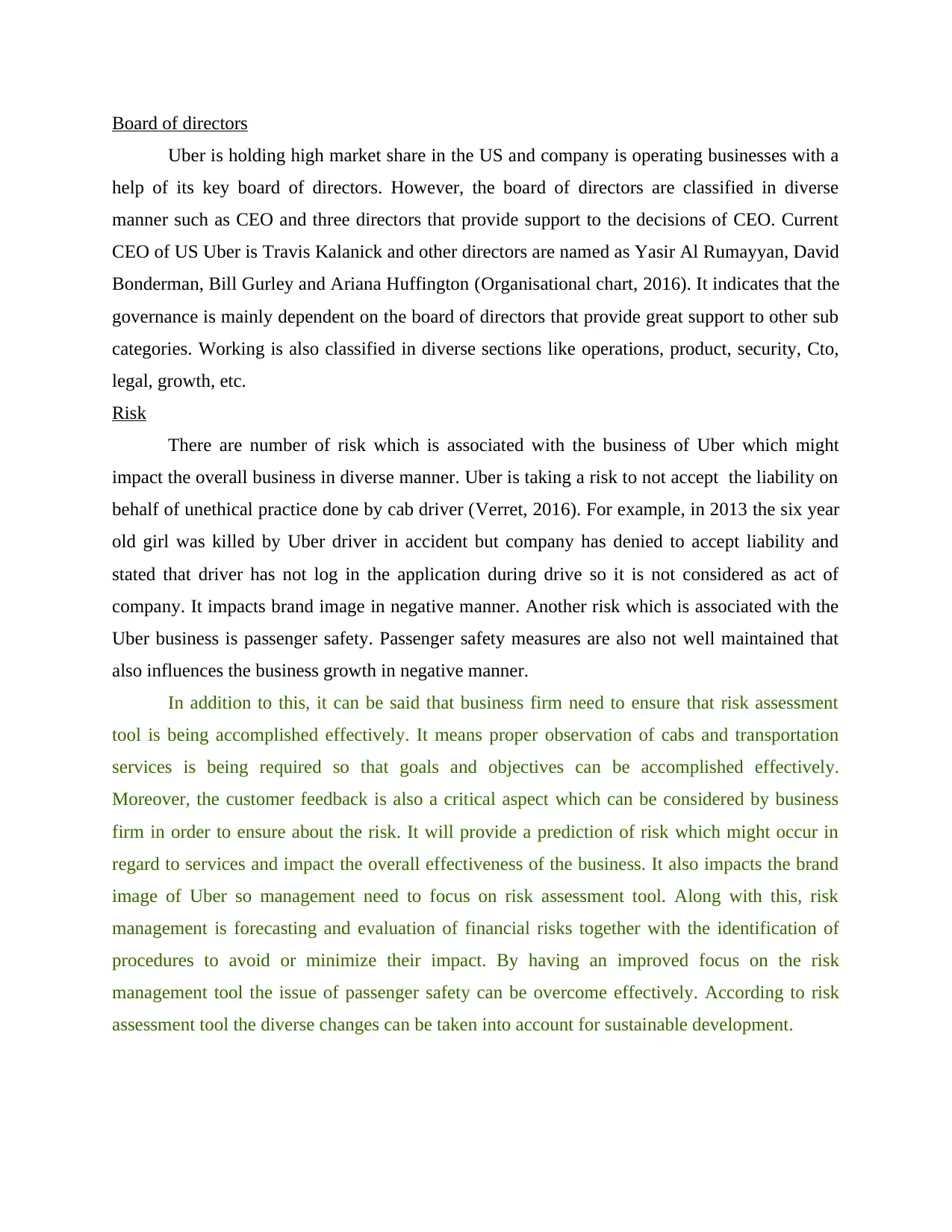
Board of directors
Uber is holding high market share in the US and company is operating businesses with a
help of its key board of directors. However, the board of directors are classified in diverse
manner such as CEO and three directors that provide support to the decisions of CEO. Current
CEO of US Uber is Travis Kalanick and other directors are named as Yasir Al Rumayyan, David
Bonderman, Bill Gurley and Ariana Huffington (Organisational chart, 2016). It indicates that the
governance is mainly dependent on the board of directors that provide great support to other sub
categories. Working is also classified in diverse sections like operations, product, security, Cto,
legal, growth, etc.
Risk
There are number of risk which is associated with the business of Uber which might
impact the overall business in diverse manner. Uber is taking a risk to not accept the liability on
behalf of unethical practice done by cab driver (Verret, 2016). For example, in 2013 the six year
old girl was killed by Uber driver in accident but company has denied to accept liability and
stated that driver has not log in the application during drive so it is not considered as act of
company. It impacts brand image in negative manner. Another risk which is associated with the
Uber business is passenger safety. Passenger safety measures are also not well maintained that
also influences the business growth in negative manner.
In addition to this, it can be said that business firm need to ensure that risk assessment
tool is being accomplished effectively. It means proper observation of cabs and transportation
services is being required so that goals and objectives can be accomplished effectively.
Moreover, the customer feedback is also a critical aspect which can be considered by business
firm in order to ensure about the risk. It will provide a prediction of risk which might occur in
regard to services and impact the overall effectiveness of the business. It also impacts the brand
image of Uber so management need to focus on risk assessment tool. Along with this, risk
management is forecasting and evaluation of financial risks together with the identification of
procedures to avoid or minimize their impact. By having an improved focus on the risk
management tool the issue of passenger safety can be overcome effectively. According to risk
assessment tool the diverse changes can be taken into account for sustainable development.
Uber is holding high market share in the US and company is operating businesses with a
help of its key board of directors. However, the board of directors are classified in diverse
manner such as CEO and three directors that provide support to the decisions of CEO. Current
CEO of US Uber is Travis Kalanick and other directors are named as Yasir Al Rumayyan, David
Bonderman, Bill Gurley and Ariana Huffington (Organisational chart, 2016). It indicates that the
governance is mainly dependent on the board of directors that provide great support to other sub
categories. Working is also classified in diverse sections like operations, product, security, Cto,
legal, growth, etc.
Risk
There are number of risk which is associated with the business of Uber which might
impact the overall business in diverse manner. Uber is taking a risk to not accept the liability on
behalf of unethical practice done by cab driver (Verret, 2016). For example, in 2013 the six year
old girl was killed by Uber driver in accident but company has denied to accept liability and
stated that driver has not log in the application during drive so it is not considered as act of
company. It impacts brand image in negative manner. Another risk which is associated with the
Uber business is passenger safety. Passenger safety measures are also not well maintained that
also influences the business growth in negative manner.
In addition to this, it can be said that business firm need to ensure that risk assessment
tool is being accomplished effectively. It means proper observation of cabs and transportation
services is being required so that goals and objectives can be accomplished effectively.
Moreover, the customer feedback is also a critical aspect which can be considered by business
firm in order to ensure about the risk. It will provide a prediction of risk which might occur in
regard to services and impact the overall effectiveness of the business. It also impacts the brand
image of Uber so management need to focus on risk assessment tool. Along with this, risk
management is forecasting and evaluation of financial risks together with the identification of
procedures to avoid or minimize their impact. By having an improved focus on the risk
management tool the issue of passenger safety can be overcome effectively. According to risk
assessment tool the diverse changes can be taken into account for sustainable development.
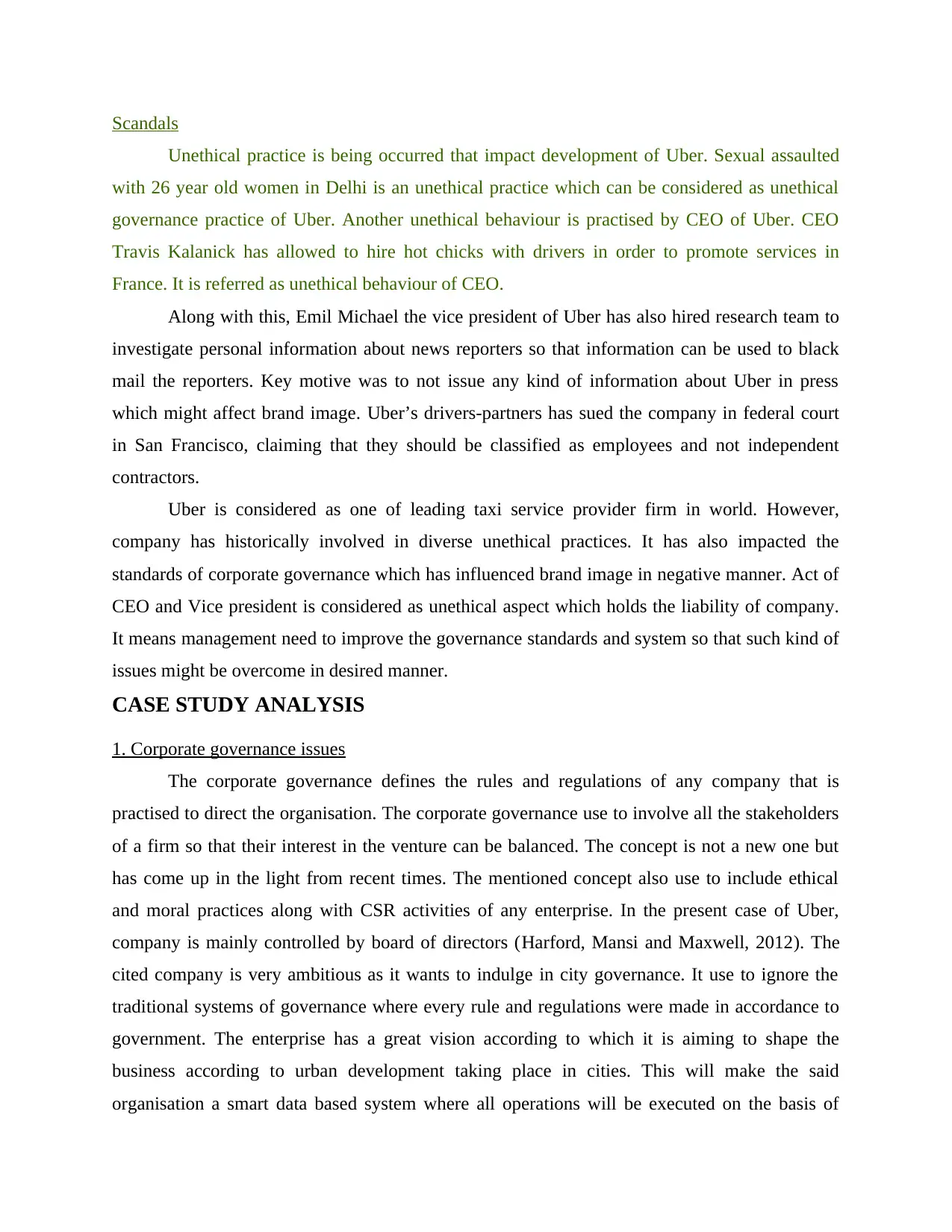
Scandals
Unethical practice is being occurred that impact development of Uber. Sexual assaulted
with 26 year old women in Delhi is an unethical practice which can be considered as unethical
governance practice of Uber. Another unethical behaviour is practised by CEO of Uber. CEO
Travis Kalanick has allowed to hire hot chicks with drivers in order to promote services in
France. It is referred as unethical behaviour of CEO.
Along with this, Emil Michael the vice president of Uber has also hired research team to
investigate personal information about news reporters so that information can be used to black
mail the reporters. Key motive was to not issue any kind of information about Uber in press
which might affect brand image. Uber’s drivers-partners has sued the company in federal court
in San Francisco, claiming that they should be classified as employees and not independent
contractors.
Uber is considered as one of leading taxi service provider firm in world. However,
company has historically involved in diverse unethical practices. It has also impacted the
standards of corporate governance which has influenced brand image in negative manner. Act of
CEO and Vice president is considered as unethical aspect which holds the liability of company.
It means management need to improve the governance standards and system so that such kind of
issues might be overcome in desired manner.
CASE STUDY ANALYSIS
1. Corporate governance issues
The corporate governance defines the rules and regulations of any company that is
practised to direct the organisation. The corporate governance use to involve all the stakeholders
of a firm so that their interest in the venture can be balanced. The concept is not a new one but
has come up in the light from recent times. The mentioned concept also use to include ethical
and moral practices along with CSR activities of any enterprise. In the present case of Uber,
company is mainly controlled by board of directors (Harford, Mansi and Maxwell, 2012). The
cited company is very ambitious as it wants to indulge in city governance. It use to ignore the
traditional systems of governance where every rule and regulations were made in accordance to
government. The enterprise has a great vision according to which it is aiming to shape the
business according to urban development taking place in cities. This will make the said
organisation a smart data based system where all operations will be executed on the basis of
Unethical practice is being occurred that impact development of Uber. Sexual assaulted
with 26 year old women in Delhi is an unethical practice which can be considered as unethical
governance practice of Uber. Another unethical behaviour is practised by CEO of Uber. CEO
Travis Kalanick has allowed to hire hot chicks with drivers in order to promote services in
France. It is referred as unethical behaviour of CEO.
Along with this, Emil Michael the vice president of Uber has also hired research team to
investigate personal information about news reporters so that information can be used to black
mail the reporters. Key motive was to not issue any kind of information about Uber in press
which might affect brand image. Uber’s drivers-partners has sued the company in federal court
in San Francisco, claiming that they should be classified as employees and not independent
contractors.
Uber is considered as one of leading taxi service provider firm in world. However,
company has historically involved in diverse unethical practices. It has also impacted the
standards of corporate governance which has influenced brand image in negative manner. Act of
CEO and Vice president is considered as unethical aspect which holds the liability of company.
It means management need to improve the governance standards and system so that such kind of
issues might be overcome in desired manner.
CASE STUDY ANALYSIS
1. Corporate governance issues
The corporate governance defines the rules and regulations of any company that is
practised to direct the organisation. The corporate governance use to involve all the stakeholders
of a firm so that their interest in the venture can be balanced. The concept is not a new one but
has come up in the light from recent times. The mentioned concept also use to include ethical
and moral practices along with CSR activities of any enterprise. In the present case of Uber,
company is mainly controlled by board of directors (Harford, Mansi and Maxwell, 2012). The
cited company is very ambitious as it wants to indulge in city governance. It use to ignore the
traditional systems of governance where every rule and regulations were made in accordance to
government. The enterprise has a great vision according to which it is aiming to shape the
business according to urban development taking place in cities. This will make the said
organisation a smart data based system where all operations will be executed on the basis of
⊘ This is a preview!⊘
Do you want full access?
Subscribe today to unlock all pages.

Trusted by 1+ million students worldwide
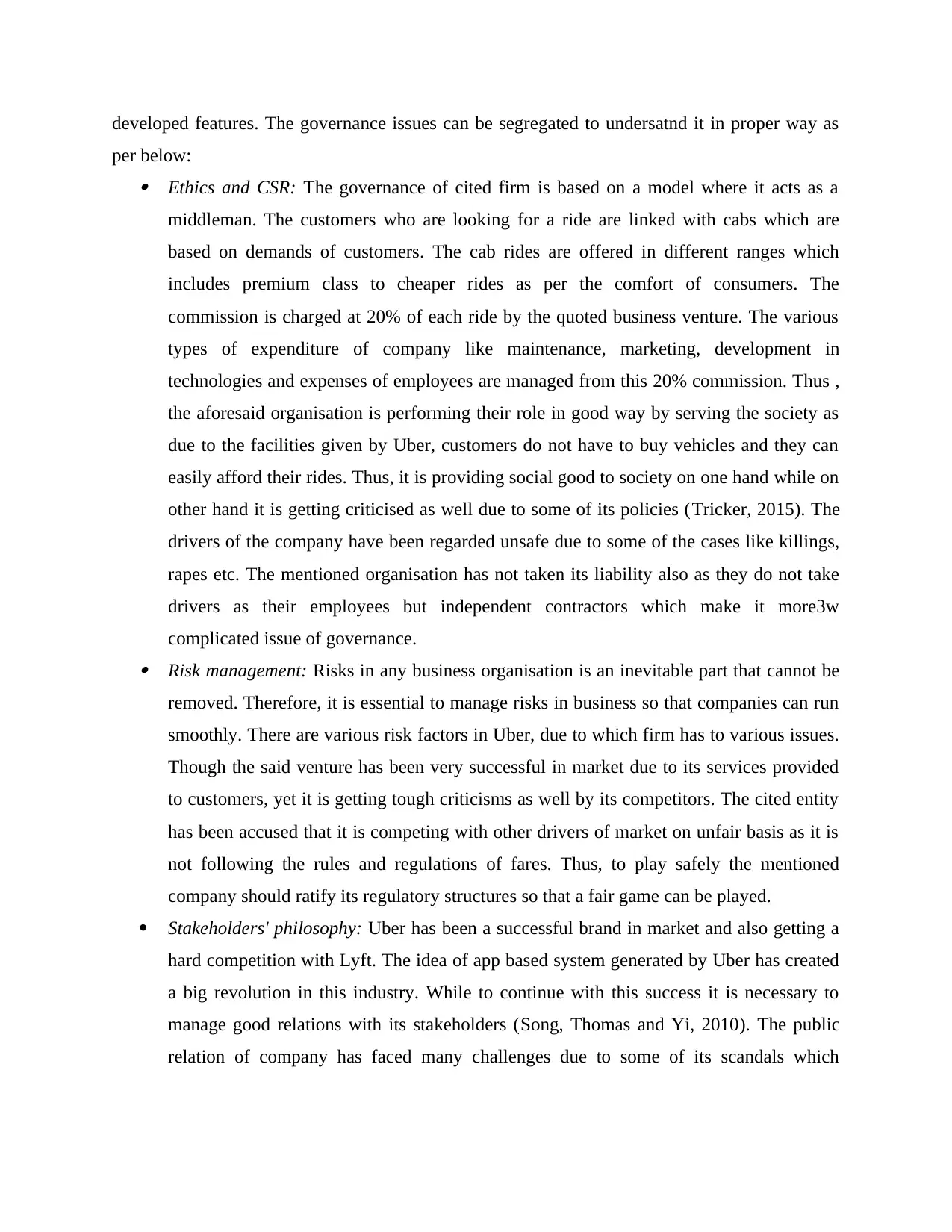
developed features. The governance issues can be segregated to undersatnd it in proper way as
per below: Ethics and CSR: The governance of cited firm is based on a model where it acts as a
middleman. The customers who are looking for a ride are linked with cabs which are
based on demands of customers. The cab rides are offered in different ranges which
includes premium class to cheaper rides as per the comfort of consumers. The
commission is charged at 20% of each ride by the quoted business venture. The various
types of expenditure of company like maintenance, marketing, development in
technologies and expenses of employees are managed from this 20% commission. Thus ,
the aforesaid organisation is performing their role in good way by serving the society as
due to the facilities given by Uber, customers do not have to buy vehicles and they can
easily afford their rides. Thus, it is providing social good to society on one hand while on
other hand it is getting criticised as well due to some of its policies (Tricker, 2015). The
drivers of the company have been regarded unsafe due to some of the cases like killings,
rapes etc. The mentioned organisation has not taken its liability also as they do not take
drivers as their employees but independent contractors which make it more3w
complicated issue of governance. Risk management: Risks in any business organisation is an inevitable part that cannot be
removed. Therefore, it is essential to manage risks in business so that companies can run
smoothly. There are various risk factors in Uber, due to which firm has to various issues.
Though the said venture has been very successful in market due to its services provided
to customers, yet it is getting tough criticisms as well by its competitors. The cited entity
has been accused that it is competing with other drivers of market on unfair basis as it is
not following the rules and regulations of fares. Thus, to play safely the mentioned
company should ratify its regulatory structures so that a fair game can be played.
Stakeholders' philosophy: Uber has been a successful brand in market and also getting a
hard competition with Lyft. The idea of app based system generated by Uber has created
a big revolution in this industry. While to continue with this success it is necessary to
manage good relations with its stakeholders (Song, Thomas and Yi, 2010). The public
relation of company has faced many challenges due to some of its scandals which
per below: Ethics and CSR: The governance of cited firm is based on a model where it acts as a
middleman. The customers who are looking for a ride are linked with cabs which are
based on demands of customers. The cab rides are offered in different ranges which
includes premium class to cheaper rides as per the comfort of consumers. The
commission is charged at 20% of each ride by the quoted business venture. The various
types of expenditure of company like maintenance, marketing, development in
technologies and expenses of employees are managed from this 20% commission. Thus ,
the aforesaid organisation is performing their role in good way by serving the society as
due to the facilities given by Uber, customers do not have to buy vehicles and they can
easily afford their rides. Thus, it is providing social good to society on one hand while on
other hand it is getting criticised as well due to some of its policies (Tricker, 2015). The
drivers of the company have been regarded unsafe due to some of the cases like killings,
rapes etc. The mentioned organisation has not taken its liability also as they do not take
drivers as their employees but independent contractors which make it more3w
complicated issue of governance. Risk management: Risks in any business organisation is an inevitable part that cannot be
removed. Therefore, it is essential to manage risks in business so that companies can run
smoothly. There are various risk factors in Uber, due to which firm has to various issues.
Though the said venture has been very successful in market due to its services provided
to customers, yet it is getting tough criticisms as well by its competitors. The cited entity
has been accused that it is competing with other drivers of market on unfair basis as it is
not following the rules and regulations of fares. Thus, to play safely the mentioned
company should ratify its regulatory structures so that a fair game can be played.
Stakeholders' philosophy: Uber has been a successful brand in market and also getting a
hard competition with Lyft. The idea of app based system generated by Uber has created
a big revolution in this industry. While to continue with this success it is necessary to
manage good relations with its stakeholders (Song, Thomas and Yi, 2010). The public
relation of company has faced many challenges due to some of its scandals which
Paraphrase This Document
Need a fresh take? Get an instant paraphrase of this document with our AI Paraphraser
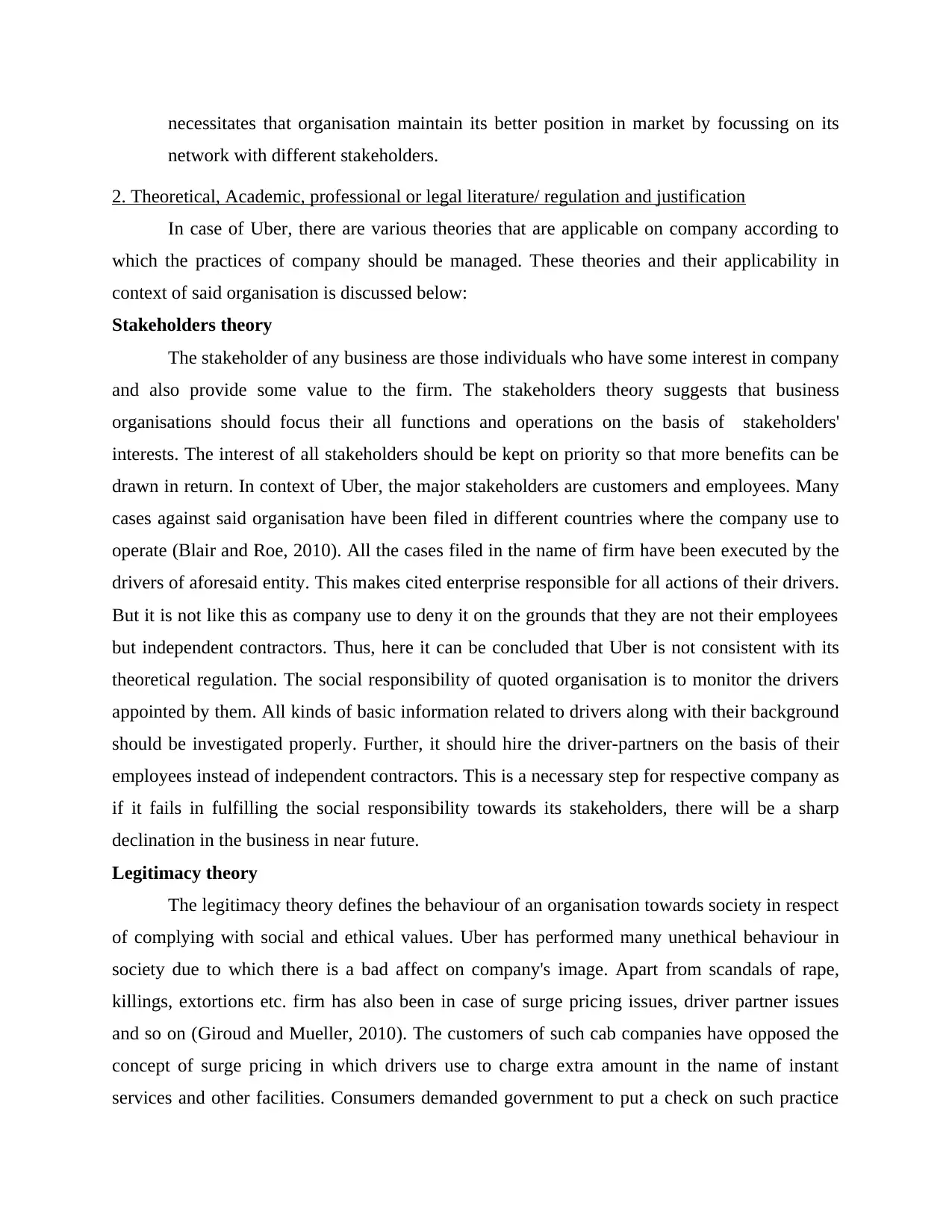
necessitates that organisation maintain its better position in market by focussing on its
network with different stakeholders.
2. Theoretical, Academic, professional or legal literature/ regulation and justification
In case of Uber, there are various theories that are applicable on company according to
which the practices of company should be managed. These theories and their applicability in
context of said organisation is discussed below:
Stakeholders theory
The stakeholder of any business are those individuals who have some interest in company
and also provide some value to the firm. The stakeholders theory suggests that business
organisations should focus their all functions and operations on the basis of stakeholders'
interests. The interest of all stakeholders should be kept on priority so that more benefits can be
drawn in return. In context of Uber, the major stakeholders are customers and employees. Many
cases against said organisation have been filed in different countries where the company use to
operate (Blair and Roe, 2010). All the cases filed in the name of firm have been executed by the
drivers of aforesaid entity. This makes cited enterprise responsible for all actions of their drivers.
But it is not like this as company use to deny it on the grounds that they are not their employees
but independent contractors. Thus, here it can be concluded that Uber is not consistent with its
theoretical regulation. The social responsibility of quoted organisation is to monitor the drivers
appointed by them. All kinds of basic information related to drivers along with their background
should be investigated properly. Further, it should hire the driver-partners on the basis of their
employees instead of independent contractors. This is a necessary step for respective company as
if it fails in fulfilling the social responsibility towards its stakeholders, there will be a sharp
declination in the business in near future.
Legitimacy theory
The legitimacy theory defines the behaviour of an organisation towards society in respect
of complying with social and ethical values. Uber has performed many unethical behaviour in
society due to which there is a bad affect on company's image. Apart from scandals of rape,
killings, extortions etc. firm has also been in case of surge pricing issues, driver partner issues
and so on (Giroud and Mueller, 2010). The customers of such cab companies have opposed the
concept of surge pricing in which drivers use to charge extra amount in the name of instant
services and other facilities. Consumers demanded government to put a check on such practice
network with different stakeholders.
2. Theoretical, Academic, professional or legal literature/ regulation and justification
In case of Uber, there are various theories that are applicable on company according to
which the practices of company should be managed. These theories and their applicability in
context of said organisation is discussed below:
Stakeholders theory
The stakeholder of any business are those individuals who have some interest in company
and also provide some value to the firm. The stakeholders theory suggests that business
organisations should focus their all functions and operations on the basis of stakeholders'
interests. The interest of all stakeholders should be kept on priority so that more benefits can be
drawn in return. In context of Uber, the major stakeholders are customers and employees. Many
cases against said organisation have been filed in different countries where the company use to
operate (Blair and Roe, 2010). All the cases filed in the name of firm have been executed by the
drivers of aforesaid entity. This makes cited enterprise responsible for all actions of their drivers.
But it is not like this as company use to deny it on the grounds that they are not their employees
but independent contractors. Thus, here it can be concluded that Uber is not consistent with its
theoretical regulation. The social responsibility of quoted organisation is to monitor the drivers
appointed by them. All kinds of basic information related to drivers along with their background
should be investigated properly. Further, it should hire the driver-partners on the basis of their
employees instead of independent contractors. This is a necessary step for respective company as
if it fails in fulfilling the social responsibility towards its stakeholders, there will be a sharp
declination in the business in near future.
Legitimacy theory
The legitimacy theory defines the behaviour of an organisation towards society in respect
of complying with social and ethical values. Uber has performed many unethical behaviour in
society due to which there is a bad affect on company's image. Apart from scandals of rape,
killings, extortions etc. firm has also been in case of surge pricing issues, driver partner issues
and so on (Giroud and Mueller, 2010). The customers of such cab companies have opposed the
concept of surge pricing in which drivers use to charge extra amount in the name of instant
services and other facilities. Consumers demanded government to put a check on such practice
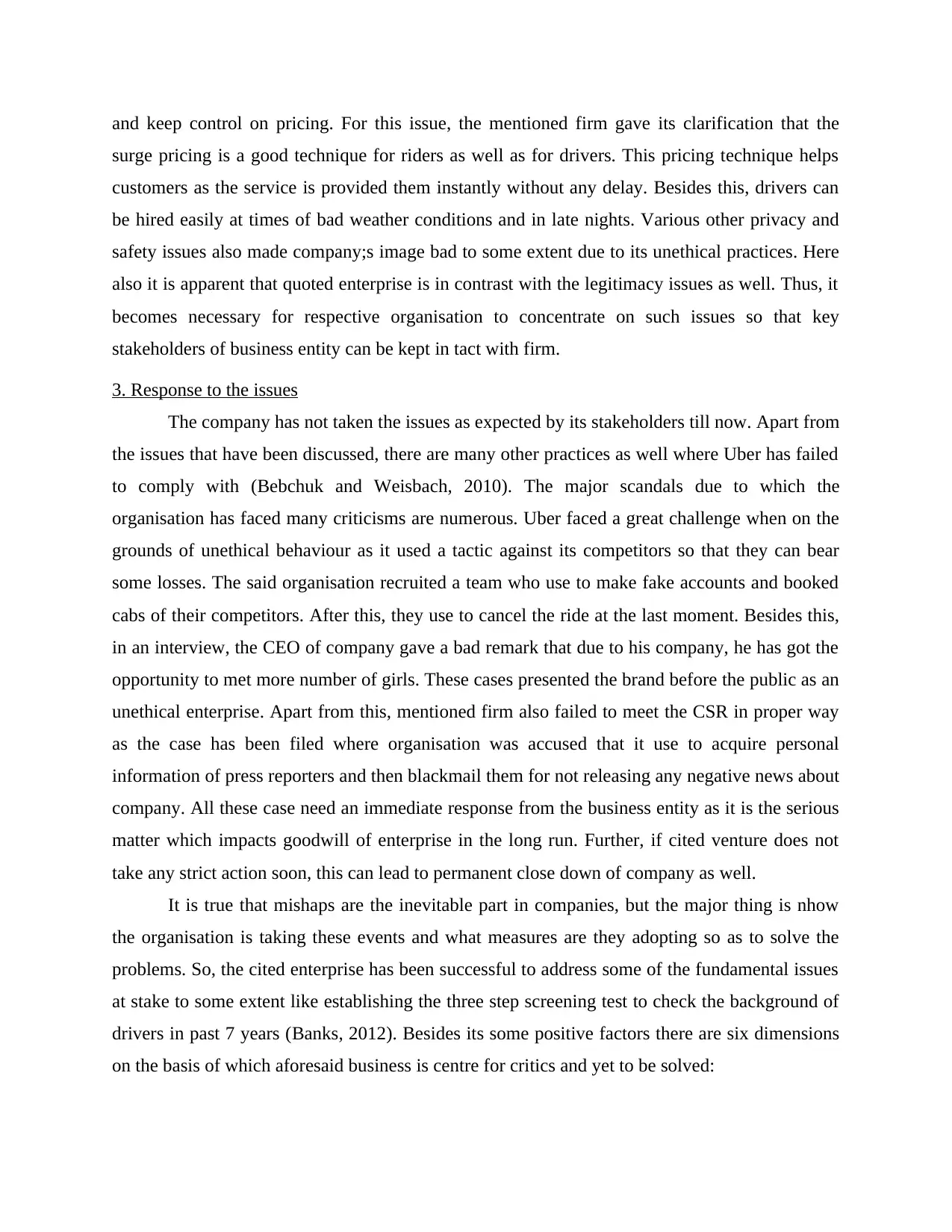
and keep control on pricing. For this issue, the mentioned firm gave its clarification that the
surge pricing is a good technique for riders as well as for drivers. This pricing technique helps
customers as the service is provided them instantly without any delay. Besides this, drivers can
be hired easily at times of bad weather conditions and in late nights. Various other privacy and
safety issues also made company;s image bad to some extent due to its unethical practices. Here
also it is apparent that quoted enterprise is in contrast with the legitimacy issues as well. Thus, it
becomes necessary for respective organisation to concentrate on such issues so that key
stakeholders of business entity can be kept in tact with firm.
3. Response to the issues
The company has not taken the issues as expected by its stakeholders till now. Apart from
the issues that have been discussed, there are many other practices as well where Uber has failed
to comply with (Bebchuk and Weisbach, 2010). The major scandals due to which the
organisation has faced many criticisms are numerous. Uber faced a great challenge when on the
grounds of unethical behaviour as it used a tactic against its competitors so that they can bear
some losses. The said organisation recruited a team who use to make fake accounts and booked
cabs of their competitors. After this, they use to cancel the ride at the last moment. Besides this,
in an interview, the CEO of company gave a bad remark that due to his company, he has got the
opportunity to met more number of girls. These cases presented the brand before the public as an
unethical enterprise. Apart from this, mentioned firm also failed to meet the CSR in proper way
as the case has been filed where organisation was accused that it use to acquire personal
information of press reporters and then blackmail them for not releasing any negative news about
company. All these case need an immediate response from the business entity as it is the serious
matter which impacts goodwill of enterprise in the long run. Further, if cited venture does not
take any strict action soon, this can lead to permanent close down of company as well.
It is true that mishaps are the inevitable part in companies, but the major thing is nhow
the organisation is taking these events and what measures are they adopting so as to solve the
problems. So, the cited enterprise has been successful to address some of the fundamental issues
at stake to some extent like establishing the three step screening test to check the background of
drivers in past 7 years (Banks, 2012). Besides its some positive factors there are six dimensions
on the basis of which aforesaid business is centre for critics and yet to be solved:
surge pricing is a good technique for riders as well as for drivers. This pricing technique helps
customers as the service is provided them instantly without any delay. Besides this, drivers can
be hired easily at times of bad weather conditions and in late nights. Various other privacy and
safety issues also made company;s image bad to some extent due to its unethical practices. Here
also it is apparent that quoted enterprise is in contrast with the legitimacy issues as well. Thus, it
becomes necessary for respective organisation to concentrate on such issues so that key
stakeholders of business entity can be kept in tact with firm.
3. Response to the issues
The company has not taken the issues as expected by its stakeholders till now. Apart from
the issues that have been discussed, there are many other practices as well where Uber has failed
to comply with (Bebchuk and Weisbach, 2010). The major scandals due to which the
organisation has faced many criticisms are numerous. Uber faced a great challenge when on the
grounds of unethical behaviour as it used a tactic against its competitors so that they can bear
some losses. The said organisation recruited a team who use to make fake accounts and booked
cabs of their competitors. After this, they use to cancel the ride at the last moment. Besides this,
in an interview, the CEO of company gave a bad remark that due to his company, he has got the
opportunity to met more number of girls. These cases presented the brand before the public as an
unethical enterprise. Apart from this, mentioned firm also failed to meet the CSR in proper way
as the case has been filed where organisation was accused that it use to acquire personal
information of press reporters and then blackmail them for not releasing any negative news about
company. All these case need an immediate response from the business entity as it is the serious
matter which impacts goodwill of enterprise in the long run. Further, if cited venture does not
take any strict action soon, this can lead to permanent close down of company as well.
It is true that mishaps are the inevitable part in companies, but the major thing is nhow
the organisation is taking these events and what measures are they adopting so as to solve the
problems. So, the cited enterprise has been successful to address some of the fundamental issues
at stake to some extent like establishing the three step screening test to check the background of
drivers in past 7 years (Banks, 2012). Besides its some positive factors there are six dimensions
on the basis of which aforesaid business is centre for critics and yet to be solved:
⊘ This is a preview!⊘
Do you want full access?
Subscribe today to unlock all pages.

Trusted by 1+ million students worldwide
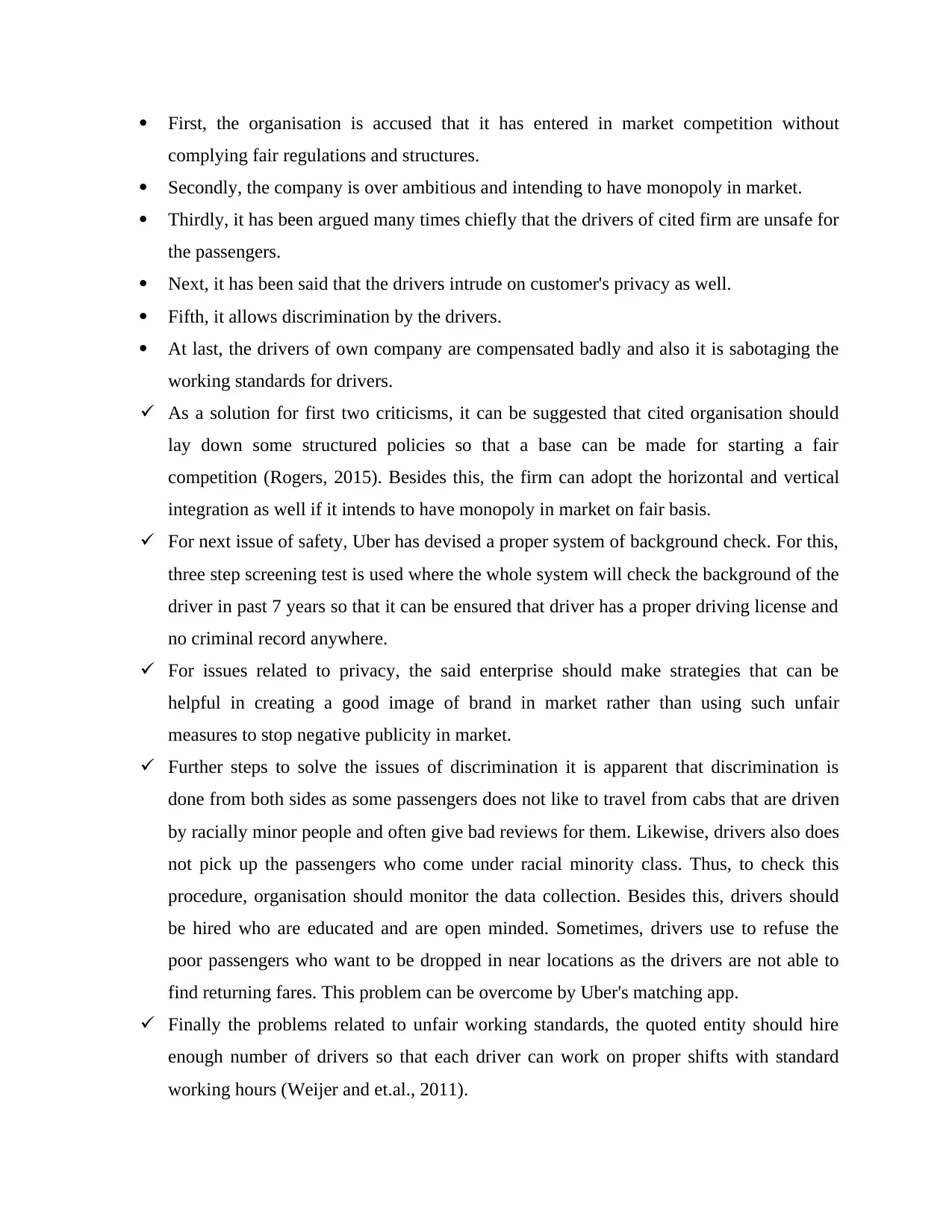
First, the organisation is accused that it has entered in market competition without
complying fair regulations and structures.
Secondly, the company is over ambitious and intending to have monopoly in market.
Thirdly, it has been argued many times chiefly that the drivers of cited firm are unsafe for
the passengers.
Next, it has been said that the drivers intrude on customer's privacy as well.
Fifth, it allows discrimination by the drivers.
At last, the drivers of own company are compensated badly and also it is sabotaging the
working standards for drivers.
As a solution for first two criticisms, it can be suggested that cited organisation should
lay down some structured policies so that a base can be made for starting a fair
competition (Rogers, 2015). Besides this, the firm can adopt the horizontal and vertical
integration as well if it intends to have monopoly in market on fair basis.
For next issue of safety, Uber has devised a proper system of background check. For this,
three step screening test is used where the whole system will check the background of the
driver in past 7 years so that it can be ensured that driver has a proper driving license and
no criminal record anywhere.
For issues related to privacy, the said enterprise should make strategies that can be
helpful in creating a good image of brand in market rather than using such unfair
measures to stop negative publicity in market.
Further steps to solve the issues of discrimination it is apparent that discrimination is
done from both sides as some passengers does not like to travel from cabs that are driven
by racially minor people and often give bad reviews for them. Likewise, drivers also does
not pick up the passengers who come under racial minority class. Thus, to check this
procedure, organisation should monitor the data collection. Besides this, drivers should
be hired who are educated and are open minded. Sometimes, drivers use to refuse the
poor passengers who want to be dropped in near locations as the drivers are not able to
find returning fares. This problem can be overcome by Uber's matching app.
Finally the problems related to unfair working standards, the quoted entity should hire
enough number of drivers so that each driver can work on proper shifts with standard
working hours (Weijer and et.al., 2011).
complying fair regulations and structures.
Secondly, the company is over ambitious and intending to have monopoly in market.
Thirdly, it has been argued many times chiefly that the drivers of cited firm are unsafe for
the passengers.
Next, it has been said that the drivers intrude on customer's privacy as well.
Fifth, it allows discrimination by the drivers.
At last, the drivers of own company are compensated badly and also it is sabotaging the
working standards for drivers.
As a solution for first two criticisms, it can be suggested that cited organisation should
lay down some structured policies so that a base can be made for starting a fair
competition (Rogers, 2015). Besides this, the firm can adopt the horizontal and vertical
integration as well if it intends to have monopoly in market on fair basis.
For next issue of safety, Uber has devised a proper system of background check. For this,
three step screening test is used where the whole system will check the background of the
driver in past 7 years so that it can be ensured that driver has a proper driving license and
no criminal record anywhere.
For issues related to privacy, the said enterprise should make strategies that can be
helpful in creating a good image of brand in market rather than using such unfair
measures to stop negative publicity in market.
Further steps to solve the issues of discrimination it is apparent that discrimination is
done from both sides as some passengers does not like to travel from cabs that are driven
by racially minor people and often give bad reviews for them. Likewise, drivers also does
not pick up the passengers who come under racial minority class. Thus, to check this
procedure, organisation should monitor the data collection. Besides this, drivers should
be hired who are educated and are open minded. Sometimes, drivers use to refuse the
poor passengers who want to be dropped in near locations as the drivers are not able to
find returning fares. This problem can be overcome by Uber's matching app.
Finally the problems related to unfair working standards, the quoted entity should hire
enough number of drivers so that each driver can work on proper shifts with standard
working hours (Weijer and et.al., 2011).
Paraphrase This Document
Need a fresh take? Get an instant paraphrase of this document with our AI Paraphraser
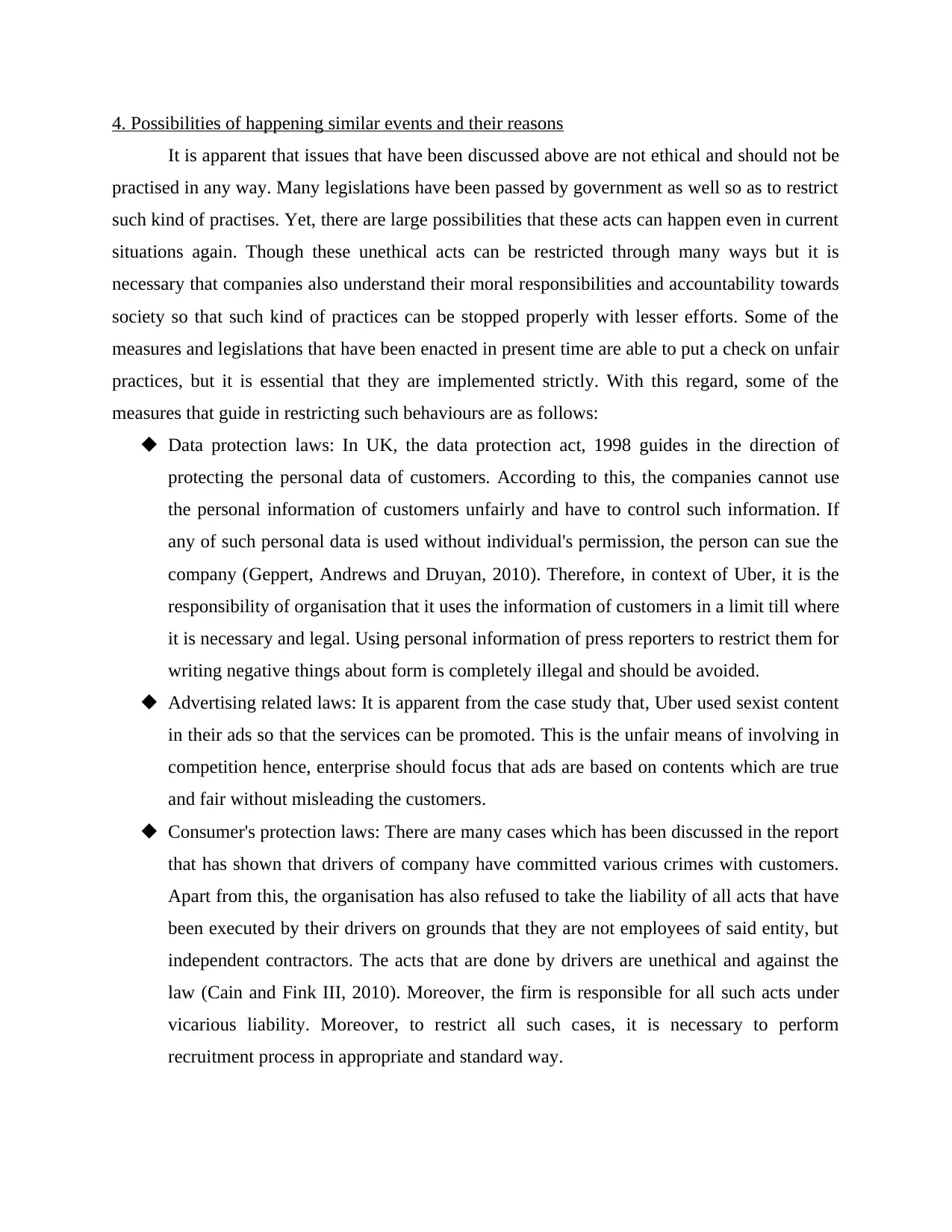
4. Possibilities of happening similar events and their reasons
It is apparent that issues that have been discussed above are not ethical and should not be
practised in any way. Many legislations have been passed by government as well so as to restrict
such kind of practises. Yet, there are large possibilities that these acts can happen even in current
situations again. Though these unethical acts can be restricted through many ways but it is
necessary that companies also understand their moral responsibilities and accountability towards
society so that such kind of practices can be stopped properly with lesser efforts. Some of the
measures and legislations that have been enacted in present time are able to put a check on unfair
practices, but it is essential that they are implemented strictly. With this regard, some of the
measures that guide in restricting such behaviours are as follows:
Data protection laws: In UK, the data protection act, 1998 guides in the direction of
protecting the personal data of customers. According to this, the companies cannot use
the personal information of customers unfairly and have to control such information. If
any of such personal data is used without individual's permission, the person can sue the
company (Geppert, Andrews and Druyan, 2010). Therefore, in context of Uber, it is the
responsibility of organisation that it uses the information of customers in a limit till where
it is necessary and legal. Using personal information of press reporters to restrict them for
writing negative things about form is completely illegal and should be avoided.
Advertising related laws: It is apparent from the case study that, Uber used sexist content
in their ads so that the services can be promoted. This is the unfair means of involving in
competition hence, enterprise should focus that ads are based on contents which are true
and fair without misleading the customers.
Consumer's protection laws: There are many cases which has been discussed in the report
that has shown that drivers of company have committed various crimes with customers.
Apart from this, the organisation has also refused to take the liability of all acts that have
been executed by their drivers on grounds that they are not employees of said entity, but
independent contractors. The acts that are done by drivers are unethical and against the
law (Cain and Fink III, 2010). Moreover, the firm is responsible for all such acts under
vicarious liability. Moreover, to restrict all such cases, it is necessary to perform
recruitment process in appropriate and standard way.
It is apparent that issues that have been discussed above are not ethical and should not be
practised in any way. Many legislations have been passed by government as well so as to restrict
such kind of practises. Yet, there are large possibilities that these acts can happen even in current
situations again. Though these unethical acts can be restricted through many ways but it is
necessary that companies also understand their moral responsibilities and accountability towards
society so that such kind of practices can be stopped properly with lesser efforts. Some of the
measures and legislations that have been enacted in present time are able to put a check on unfair
practices, but it is essential that they are implemented strictly. With this regard, some of the
measures that guide in restricting such behaviours are as follows:
Data protection laws: In UK, the data protection act, 1998 guides in the direction of
protecting the personal data of customers. According to this, the companies cannot use
the personal information of customers unfairly and have to control such information. If
any of such personal data is used without individual's permission, the person can sue the
company (Geppert, Andrews and Druyan, 2010). Therefore, in context of Uber, it is the
responsibility of organisation that it uses the information of customers in a limit till where
it is necessary and legal. Using personal information of press reporters to restrict them for
writing negative things about form is completely illegal and should be avoided.
Advertising related laws: It is apparent from the case study that, Uber used sexist content
in their ads so that the services can be promoted. This is the unfair means of involving in
competition hence, enterprise should focus that ads are based on contents which are true
and fair without misleading the customers.
Consumer's protection laws: There are many cases which has been discussed in the report
that has shown that drivers of company have committed various crimes with customers.
Apart from this, the organisation has also refused to take the liability of all acts that have
been executed by their drivers on grounds that they are not employees of said entity, but
independent contractors. The acts that are done by drivers are unethical and against the
law (Cain and Fink III, 2010). Moreover, the firm is responsible for all such acts under
vicarious liability. Moreover, to restrict all such cases, it is necessary to perform
recruitment process in appropriate and standard way.
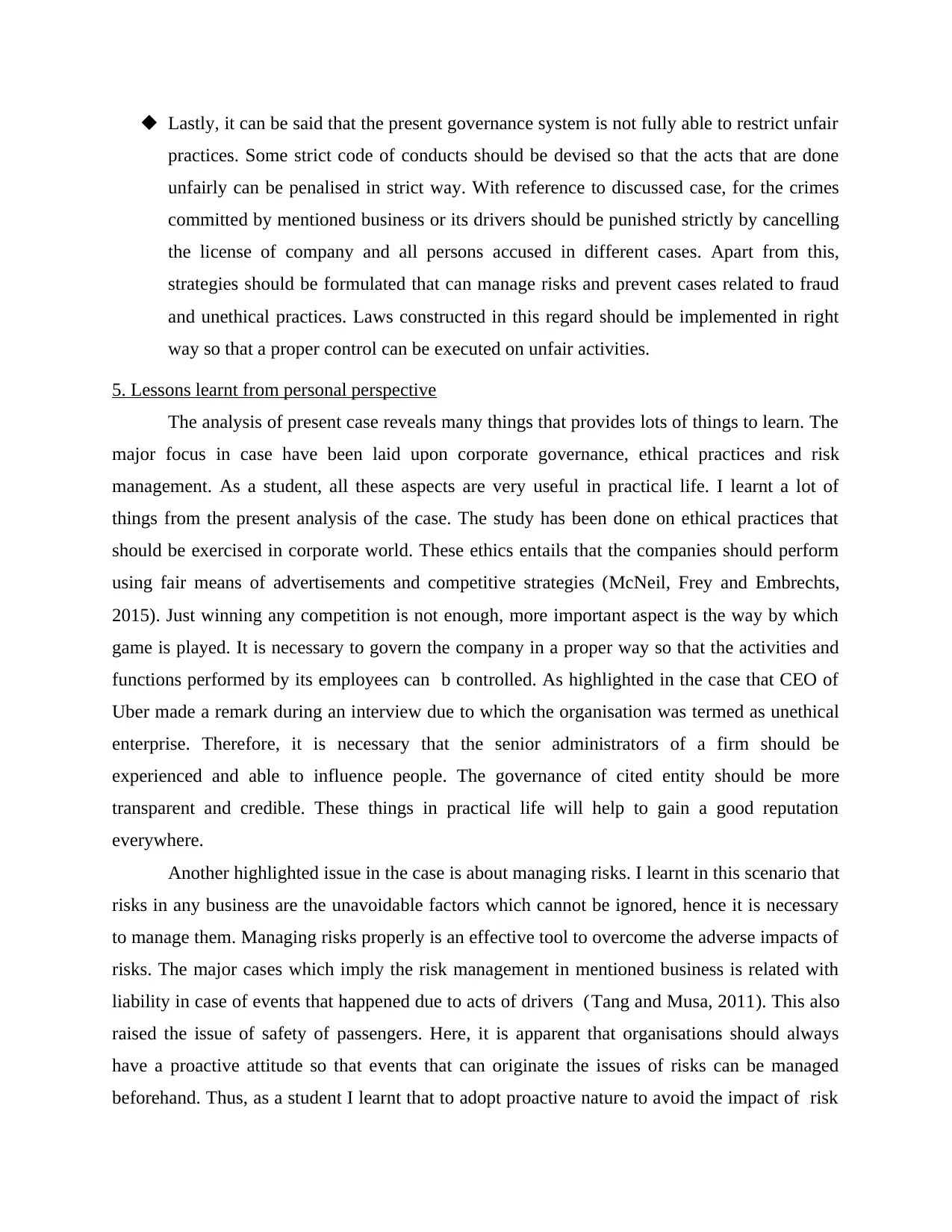
Lastly, it can be said that the present governance system is not fully able to restrict unfair
practices. Some strict code of conducts should be devised so that the acts that are done
unfairly can be penalised in strict way. With reference to discussed case, for the crimes
committed by mentioned business or its drivers should be punished strictly by cancelling
the license of company and all persons accused in different cases. Apart from this,
strategies should be formulated that can manage risks and prevent cases related to fraud
and unethical practices. Laws constructed in this regard should be implemented in right
way so that a proper control can be executed on unfair activities.
5. Lessons learnt from personal perspective
The analysis of present case reveals many things that provides lots of things to learn. The
major focus in case have been laid upon corporate governance, ethical practices and risk
management. As a student, all these aspects are very useful in practical life. I learnt a lot of
things from the present analysis of the case. The study has been done on ethical practices that
should be exercised in corporate world. These ethics entails that the companies should perform
using fair means of advertisements and competitive strategies (McNeil, Frey and Embrechts,
2015). Just winning any competition is not enough, more important aspect is the way by which
game is played. It is necessary to govern the company in a proper way so that the activities and
functions performed by its employees can b controlled. As highlighted in the case that CEO of
Uber made a remark during an interview due to which the organisation was termed as unethical
enterprise. Therefore, it is necessary that the senior administrators of a firm should be
experienced and able to influence people. The governance of cited entity should be more
transparent and credible. These things in practical life will help to gain a good reputation
everywhere.
Another highlighted issue in the case is about managing risks. I learnt in this scenario that
risks in any business are the unavoidable factors which cannot be ignored, hence it is necessary
to manage them. Managing risks properly is an effective tool to overcome the adverse impacts of
risks. The major cases which imply the risk management in mentioned business is related with
liability in case of events that happened due to acts of drivers (Tang and Musa, 2011). This also
raised the issue of safety of passengers. Here, it is apparent that organisations should always
have a proactive attitude so that events that can originate the issues of risks can be managed
beforehand. Thus, as a student I learnt that to adopt proactive nature to avoid the impact of risk
practices. Some strict code of conducts should be devised so that the acts that are done
unfairly can be penalised in strict way. With reference to discussed case, for the crimes
committed by mentioned business or its drivers should be punished strictly by cancelling
the license of company and all persons accused in different cases. Apart from this,
strategies should be formulated that can manage risks and prevent cases related to fraud
and unethical practices. Laws constructed in this regard should be implemented in right
way so that a proper control can be executed on unfair activities.
5. Lessons learnt from personal perspective
The analysis of present case reveals many things that provides lots of things to learn. The
major focus in case have been laid upon corporate governance, ethical practices and risk
management. As a student, all these aspects are very useful in practical life. I learnt a lot of
things from the present analysis of the case. The study has been done on ethical practices that
should be exercised in corporate world. These ethics entails that the companies should perform
using fair means of advertisements and competitive strategies (McNeil, Frey and Embrechts,
2015). Just winning any competition is not enough, more important aspect is the way by which
game is played. It is necessary to govern the company in a proper way so that the activities and
functions performed by its employees can b controlled. As highlighted in the case that CEO of
Uber made a remark during an interview due to which the organisation was termed as unethical
enterprise. Therefore, it is necessary that the senior administrators of a firm should be
experienced and able to influence people. The governance of cited entity should be more
transparent and credible. These things in practical life will help to gain a good reputation
everywhere.
Another highlighted issue in the case is about managing risks. I learnt in this scenario that
risks in any business are the unavoidable factors which cannot be ignored, hence it is necessary
to manage them. Managing risks properly is an effective tool to overcome the adverse impacts of
risks. The major cases which imply the risk management in mentioned business is related with
liability in case of events that happened due to acts of drivers (Tang and Musa, 2011). This also
raised the issue of safety of passengers. Here, it is apparent that organisations should always
have a proactive attitude so that events that can originate the issues of risks can be managed
beforehand. Thus, as a student I learnt that to adopt proactive nature to avoid the impact of risk
⊘ This is a preview!⊘
Do you want full access?
Subscribe today to unlock all pages.

Trusted by 1+ million students worldwide
1 out of 23
Related Documents
Your All-in-One AI-Powered Toolkit for Academic Success.
+13062052269
info@desklib.com
Available 24*7 on WhatsApp / Email
![[object Object]](/_next/static/media/star-bottom.7253800d.svg)
Unlock your academic potential
Copyright © 2020–2025 A2Z Services. All Rights Reserved. Developed and managed by ZUCOL.




